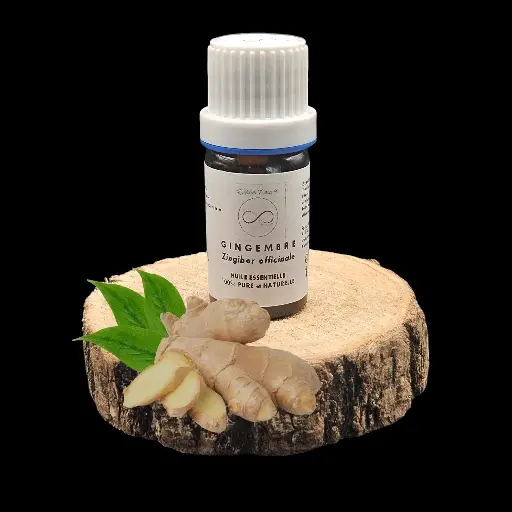Huile essentielle de Gingembre
Botanical name: Zingiber offiinalis
Distilled part: Rhizome
Botanical family: Zingiberaceae
Origin: France
Chemical composition:
Aldehydes: Citronnellal, Géranial, Myrtéal, Néral, Phéllandral
- Ketones: Cryptone, Hexanone
- Hydrocarbons
- Monoterpenes: Beta Phellandrene, Beta Pinene, Camphene (8%), Limonene, Myrcene, P Cymene
- Monoterpenols: Linalool
- Sesquiterpènes : Béta Caryophyllène, Béta Curcumène, Béta Elémène, Bisabolène (7%), Copaène, Germacrène, Zingibérène (30%)
- Sesquiterpenols: Cis Gamma Bisabolol
Divers:
The Chinese consider that ginger root stimulates and activates the circulation of the body's vital energy, mainly in the digestive system.
Do not confuse with Asarum Canadense (Indian Ginger) which has no therapeutic benefit.
Légende: * puissant,** très puissant;*** extrêmement puissant (valeur de
puissance pour la pathologie associée)
PROPRIETES PHYSIQUES ET INDICATIONS THERAPEUTIQUES:
Analgesic
Muscle analgesic*
Aphrodisiac*
Aperitif*
Bloating
Chronic bronchitis*
Carminatif*
Catarrhe
Colic
Constipation*
Diarrhea
Muscle aches
Dyspepsia*
Expectorant
Fatigue
Febrifuge
Flatulence*
frigidity
Flu
Incapacity*
Travel sickness*
Nausea*
Neuralgia
Odontalgia
Rheumatism*
Sinusitis
Stimulant digestif*
PROPRIETES EMOTIONNELLES, PSYCHIQUES ET INDICATIONS THERAPEUTIQUES:
State of weakness
Nervous overwork
Self-confidence (Gives)
Exhaustion
Sentiments (Absence)
Feelings (Hardening)
Feelings (Coldness)
Reference and bibliographic source: Lily BAYER and Dr Hervé STAUB, (2013) “In-depth treatise on Phyto and Aromatherapy”, Ed. Grancher. p. 530.
LES INDICATIONS EN AROMATHERAPIE ET L'USAGE DES HUILES ESSENTIELLES NE
CONSTITUENT PAS UN DIAGNOSTIC MEDICAL ET NE REMPLACENT PAS L'AVIS D'UN MEDECIN
NI LES TRAITEMENTS MEDICAUX





